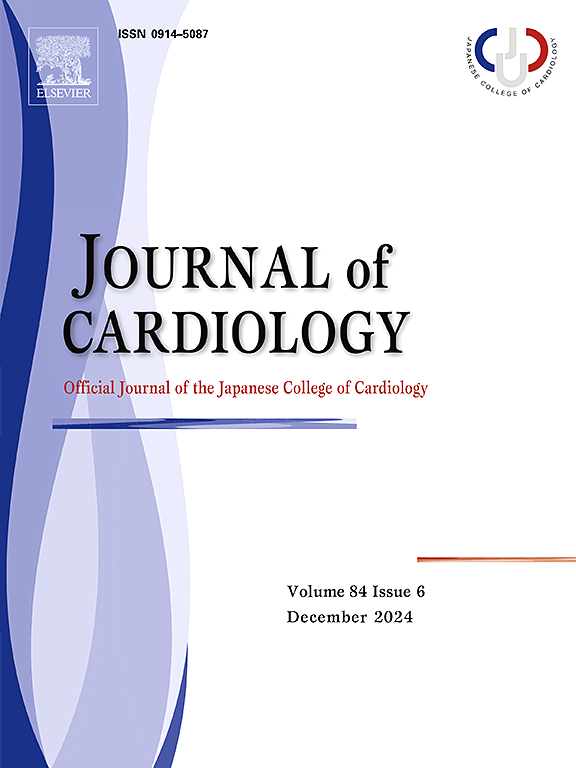表面钢球校准-在WATCHMAN植入期间促进荧光测量的新方法。
IF 2.6
3区 医学
Q2 CARDIAC & CARDIOVASCULAR SYSTEMS
引用次数: 0
摘要
背景:在经皮左心耳闭塞术(LAAO)中,虽然提出了自动校准或基于导管直径校准的方法进行透视测量,但这种方法可能不精确,导致测量错误。我们试图研究在透视下使用表面钢球校准(SSBC)方法是否可以促进LAAO植入后WATCHMAN装置(Boston Scientific Corporation, Natick, MA, USA)的透视测量。方法:本回顾性研究包括97例使用WATCHMAN装置经皮LAAO的患者。LAAO过程中采用SSBC法、透视下鞘鞘校准法和经食管超声心动图(TEE)测量植入后装置的直径。然后比较了三种方法的结果。结果:WATCHMAN手术植入成功率为100% %。post-implanted设备的平均最大直径是24.7 ± 3.1毫米,23.5 ±3.2 毫米,和24.2 ±3.0 毫米,以SSBC方法,鞘校准方法,分别和三通(所有p 结论:SSBC方法,当采用透视下,表现出高度的相关性与鞘校准方法和t形测量。它可以应用于经皮LAAO过程中方便的透视测量。本文章由计算机程序翻译,如有差异,请以英文原文为准。

Surface steel ball calibration — A novel method for facilitating fluoroscopic measurement during implantation of WATCHMAN
Background
Although the method of autocalibration or calibration based on catheter diameters was proposed for fluoroscopic measurement during percutaneous left atrial appendage occlusion (LAAO), it may be imprecise and lead to mismeasurement. We sought to investigate whether the utilization of the surface steel ball calibration (SSBC) method under fluoroscopy could facilitate the fluoroscopic measurement of the post-implanted WATCHMAN device (Boston Scientific Corporation, Natick, MA, USA) in LAAO.
Methods
This retrospective study included 97 consecutive patients who underwent percutaneous LAAO with the WATCHMAN device. The SSBC method and sheath calibration method under fluoroscopy, and transesophageal echocardiography (TEE) were employed to measure the diameter of the post-implanted device during the LAAO procedure. The results of the three methods were then compared.
Results
The success rate for procedural WATCHMAN implantation was 100 %. The mean maximal diameter of the post-implanted devices was 24.7 ± 3.1 mm, 23.5 ± 3.2 mm, and 24.2 ± 3.0 mm, as measured by the SSBC method, sheath calibration method, and TEE, respectively (all p < 0.001). The relevant coefficient of correlation between the SSBC method/TEE, SSBC method/sheath calibration method, and TEE/sheath calibration method, was 0.94, 0.93, and 0.89, respectively (all p < 0.001).
Conclusion
The SSBC method, when employed under fluoroscopy, demonstrated a high correlation with the sheath calibration method and TEE for measurements. It may be applied to facilitate fluoroscopic measurements during percutaneous LAAO procedures.
求助全文
通过发布文献求助,成功后即可免费获取论文全文。
去求助
来源期刊

Journal of cardiology
CARDIAC & CARDIOVASCULAR SYSTEMS-
CiteScore
4.90
自引率
8.00%
发文量
202
审稿时长
29 days
期刊介绍:
The official journal of the Japanese College of Cardiology is an international, English language, peer-reviewed journal publishing the latest findings in cardiovascular medicine. Journal of Cardiology (JC) aims to publish the highest-quality material covering original basic and clinical research on all aspects of cardiovascular disease. Topics covered include ischemic heart disease, cardiomyopathy, valvular heart disease, vascular disease, hypertension, arrhythmia, congenital heart disease, pharmacological and non-pharmacological treatment, new diagnostic techniques, and cardiovascular imaging. JC also publishes a selection of review articles, clinical trials, short communications, and important messages and letters to the editor.
 求助内容:
求助内容: 应助结果提醒方式:
应助结果提醒方式:


